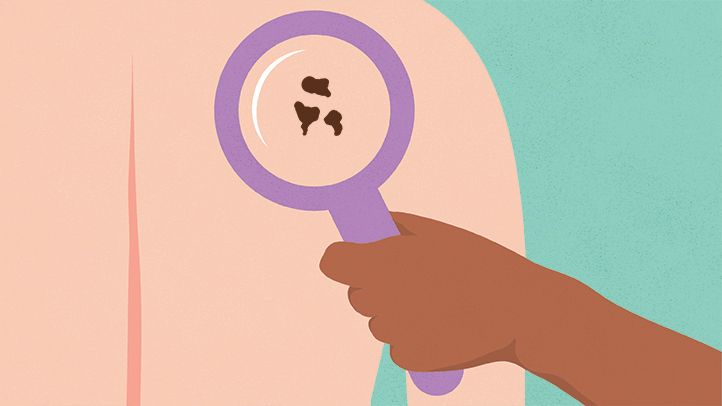Abnormal cells in skin layers grow and cause skin cancer. This widespread issue poses serious risks. The primary forms include basal cell carcinoma, squamous cell carcinoma, and melanoma. Each type differs in how bad it can get.
You might see new moles or moles that change shape as signs of skin cancer. Weird skin growths or sores that won't heal can also be symptoms. These can show up anywhere on your body. So, you need to check your skin often. You should see a dermatologist in Delhii if you notice anything unusual. Doctors treat skin cancer based on its kind, where it is, and how far it's spread. They might cut it out, use radiation, or give you special creams. Finding and treating it early makes it much more likely you'll get better. So it's important to keep an eye on your skin and how it looks.
Symptoms of skin cancer
These are the symptoms of skin cancer:
- A fresh spot on your skin or
- A variation in the size, shape, or colour of an existing spot. These alterations can vary widely, thus there is no single method to describe how a skin cancer appears.
- An uncomfortable or unpleasant spot
- Non-healing sore that bleeds or forms a crust.
- A red or flesh-coloured glossy protrusion on the surface of the skin
- A palpable red rough or scaly patch
- A growth with a raised border, centre crust, or bleeding
- A wart-like development.
- A scar-like development without a clearly defined border
Basal cell carcinoma
This type of cancer grows on the face, legs, arms, neck, ears and hands (sun-exposed parts of your body). Its symptoms include:
- You may notice shiny/skin-coloured bumps on your skin. They can also be pearly or waxy depending on your skin tone.
- Raised lesions with dark spots and translucent borders.
- Scaly spots that might expand over time.
Squamous cell carcinoma
UV rays cause this cancer. Too much sun without protection or using tanning beds can lead to it. It shows up as:
- Rough and reddish scaly region.
- Open sore (frequently with elevated border
- Brown area that resembles an ageing spot.
- Firm, dome-shaped growth.
- Wart-like growth.
- A tiny, rhinoceros-shaped horn grows from your skin.
- Soreness is growing in an old scar.
Melanoma
Melanoma starts in special skin cells called melanocytes. These cells make melanin, which gives skin its colour. Melanoma is a kind of skin cancer that begins in these melanin-producing cells. Its symptoms include:
- Moles with unusual shapes.
- Moles with different colours and unusual colour patterns.
- Moles larger than 6mm in size.
- Itchiness or bleeding in the area.
- Moles with unique notched or scalloped borders.
Treatment for skin cancer in Delhi
You must immediately start treatment if you have been diagnosed with skin cancer. The treatments are:
Common treatments
- Cryotherapy: The doctor uses liquid nitrogen to freeze the skin cancer. The dead cells are thrown away after the treatment is completed.
- Mohs Surgery: Skin cancer treatment often involves Mohs surgery. Doctors remove cancerous tissue while preserving surrounding healthy skin. It's a popular way to fix skin cancer in one spot.
- Excisional surgery is another option. The doctor cuts out the cancer cells and a bit of healthy skin nearby. It helps make sure the cancer doesn't spread more.
- Topical treatment: Some skin cancers respond to topical treatments. Doctors apply special creams to the skin. This localised chemotherapy halts cancer growth.
- Immunotherapy is different. Patients get medicine that teaches their bodies to fight cancer cells on their own. This way, they might not need a big operation.
- Radiation therapy uses strong energy beams. These beams kill cancer cells on the skin and in areas close by where the cancer has spread.
- Photodynamic therapy: Your skin doctor puts medicine on your skin and turns it on with a blue or red light that glows. This way kills cells that could turn bad but don't hurt normal ones. It's called photodynamic therapy.
- C and E is a two-part thing. The doctor first scrapes off the top of the skin cancer with a special tool. Then they burn the bottom part with an electric needle. The full name is curettage and electrodessication, but people say C and E.
Side effects of the treatments
Every treatment has a side effect. These are the following side effects of skin cancer treatments:
- Bleeding.
- Pain and swelling.
- Scars.
- Nerve injury causes loss of feeling.
- Skin infections.
- Regrowth of the tumour following its removal.
Your doctor will spot the type of skin cancer you have and give you the right treatments. You can prevent skin cancer. Avoiding excessive sun exposure and sunburns keeps you safe. Sunlight's UV rays damage your skin and can cause skin cancer. Put on sunscreen before you go outside. Also, stay indoors from 10 AM to 4 PM when the sun shines brightest.
Shielding your skin from dangerous rays has a significant influence on cancer prevention. It's smart to make sun safety a habit in your daily life. Remember small steps like wearing a hat or seeking shade can make a difference in keeping your skin healthy.
If you feel any of the symptoms above, visit the skin specialist in delhi for proper consultation and treatments.
Also read about skin acne and its treatment
